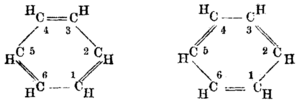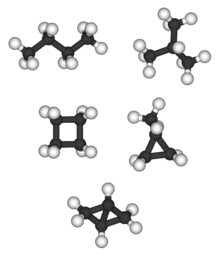Technetium is a chemical element with symbol Tc and atomic number 43. It is the lightest element of which all isotopes are radioactive; none are stable. Only one other such element, promethium, is followed (in the periodic table) by elements with stable isotopes. Nearly all technetium is produced synthetically, and only minute amounts are found in the Earth's crust. Naturally occurring technetium is a spontaneous fission product in uranium ore or the product of neutron capture in molybdenum ores. The chemical properties of this silvery gray, crystalline transition metal are intermediate between rhenium and manganese.
Many of technetium's properties were predicted by Dmitri Mendeleev before the element was discovered. Mendeleev noted a gap in his periodic table and gave the undiscovered element the provisional name ekamanganese (Em). In 1937, technetium (specifically the technetium-97 isotope) became the first predominantly artificial element to be produced, hence its name (from the Greek τεχνητός, meaning "artificial", + -ium).
Its short-lived gamma ray-emitting nuclear isomer—technetium-99m—is used in nuclear medicine for a wide variety of diagnostic tests. Technetium-99 is used as a gamma-ray-free source of beta particles. Long-lived technetium isotopes produced commercially are by-products of fission of uranium-235 in nuclear reactors and are extracted from nuclear fuel rods. Because no isotope of technetium has a half-life longer than 4.2 million years (technetium-98), the 1952 detection of technetium in red giants, which are billions of years old, helped to prove that stars can produce heavier elements.
The discovery of element 43 was finally confirmed in a December 1936 experiment at the University of Palermo in Sicily by Carlo Perrier and Emilio Segrè. In mid-1936, Segrè visited the United States, first Columbia University in New York and then the Lawrence Berkeley National Laboratory in California. He persuaded cyclotron inventor Ernest Lawrence to let him take back some discarded cyclotron parts that had become radioactive. Lawrence mailed him a molybdenum foil that had been part of the deflector in the cyclotron.
Segrè enlisted his colleague Perrier to attempt to prove, through comparative chemistry, that the molybdenum activity was indeed from an element with the atomic number 43. They succeeded in isolating the isotopes technetium-95m and technetium-97. University of Palermo officials wanted them to name their discovery "panormium", after the Latin name for Palermo, Panormus. In 1947, element 43 was named after the Greek word τεχνητός, meaning "artificial", since it was the first element to be artificially produced. Segrè returned to Berkeley and met Glenn T. Seaborg. They isolated the metastable isotopetechnetium-99m, which is now used in some ten million medical diagnostic procedures annually.
In 1952, astronomer Paul W. Merrill in California detected the spectral signature of technetium (specifically wavelengths of 403.1 nm, 423.8 nm, 426.2 nm, and 429.7 nm) in light from S-type red giants. The stars were near the end of their lives, yet were rich in this short-lived element, indicating that it was being produced in the stars by nuclear reactions. This evidence bolstered the hypothesis that heavier elements are the product of nucleosynthesis in stars. More recently, such observations provided evidence that elements are formed by neutron capture in the s-process.
Since that discovery, there have been many searches in terrestrial materials for natural sources of technetium. In 1962, technetium-99 was isolated and identified in pitchblende from the Belgian Congo in extremely small quantities (about 0.2 ng/kg). There it originates as a spontaneous fission product of uranium-238. The Oklo natural nuclear fission reactor contains evidence that significant amounts of technetium-99 were produced and have since decayed into ruthenium-99.








